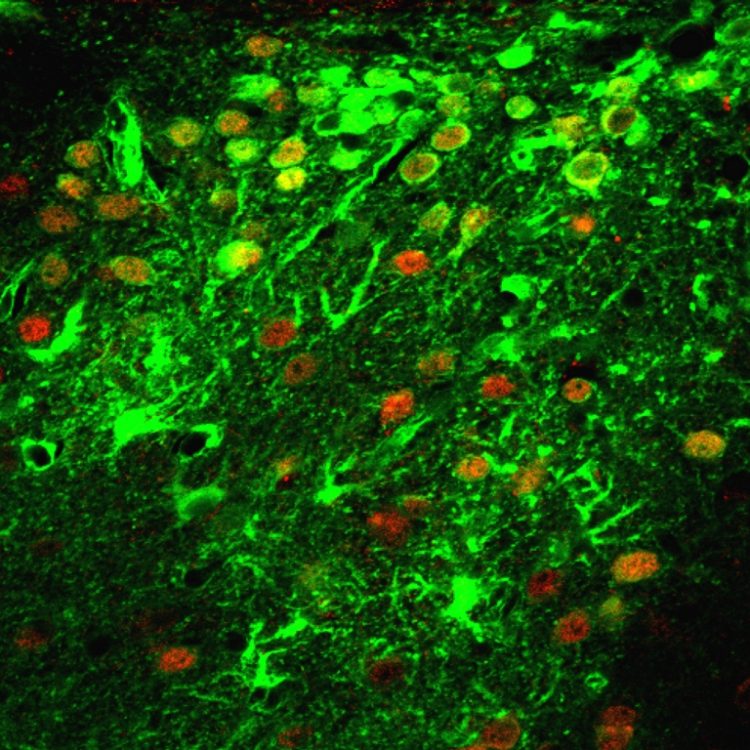Gene transfer for neurodegenerative diseases: Viral vectors travel longer distances than thought

Where viral vectors "travel" and which types of neural cells they infect, can be visualized by fluorescent Proteins being transmitted. Kirsti Witter/Vetmeduni Vienna
Purposefully infecting brain cells with viruses may seem somewhat odd. But for patients suffering from neurodegenerative diseases such as Alzheimer’s or Parkinson’s, this type of therapy could be a glimmer of hope. The viruses used in this approach do not trigger any disease themselves.
They serve as harmless transporters for genes specifically intended to treat these disorders. The therapy, called gene transfer, uses the ability of viruses to insert their genes into the genome of a host cell. This method could therefore be used to purposefully introduce helpful genetic information into neurons.
Viral vectors don’t stay put
Viruses suitable for gene transfer are injected into the brain. Previously, however, there had been no studies of how far the viral transporters can spread from the injection site. Earlier studies had usually only investigated the immediate area around the injection canal. A new study with mice has now shown for the first time that some of the tested viruses can travel long distances into different areas of the brain. “In our study, we injected the viral vectors into key areas of the cerebrum responsible, among other things, for the coordinationof body movement ,” explains Kirsti Witter from the Institute for Anatomy, Histology and Embryology at Vetmeduni Vienna. From there, some of the viruses spread into distant areas such as the cerebellum or the olfactory bulb.
“This information is important because, depending on the type of neurodegenerative disease, it may be desirable to have as broad a distribution of the virus as possible or to infect a specific, strictly delimited area,” says first author Juraj Hlavaty. “This study also shows that all tested viruses can infect the neurons and the surrounding glial cells as expected. Depending on the type of virus, however, there were differences in the number and ratio of the infected cell types.”
Inflammation could influence which brain cells are infected
Depending on the virus strain used, the injection triggered a mild or more pronounced reaction of the nerve tissue in the treated mice. The stronger the immune response, the more glial cells were infected. “The fact that individual viruses infected these cells better than the neurons must, however, still be confirmed in future experiments,” says Hlavaty.
The results of the work, achieved in collaboration with the University of West Bohemia, Pilsen, Czech Republic, and the Paul-Ehrlich-Institute, Langen, Germany, should contribute to improve the selection of viral transporters. “The goal is to create a toolbox of possible viruses in order to choose exactly the right transporter for the custom treatment of a neurodegenerative disease,” says Witter.
Artificial copies of viruses as hopeful therapy
Copies of lentiviruses are especially well-suited for gene transfer therapy. “The genome of laboratory-produced lentiviruses consists only of areas that are necessary for the infection and incorporation into the genome. This represents a fundamental difference between these viruses and naturally occurring pathogenic viruses,” explains Hlavaty. Through the ability of the artificial viruses to enter a host, the inserted human genes are introduced into the infected cells to assume the tasks that the patients’ cells no longer perform themselves.
Service:
The article “Tropism, intracerebral distribution, and transduction efficiency of HIV- and SIV-based lentiviral vectors after injection into the mouse brain: a qualitative and quantitative in vivo study“ by Juraj Hlavatý, Zbyněk Tonar, Matthias Renner, Sylvia Panitz, Helga Petznek, Matthias Schweizer, Silke Schüle, Björn‑Philipp Kloke, Rudolf Moldzio and Kirsti Witter was published in Histochemistry and Cell Biology. DOI: 10.1007/s00418-017-1569-1
https://link.springer.com/article/10.1007%2Fs00418-017-1569-1
About the University of Veterinary Medicine, Vienna
The University of Veterinary Medicine, Vienna in Austria is one of the leading academic and research institutions in the field of Veterinary Sciences in Europe. About 1,300 employees and 2,300 students work on the campus in the north of Vienna which also houses five university clinics and various research sites. Outside of Vienna the university operates Teaching and Research Farms. http://www.vetmeduni.ac.at
Scientific Contact:
Kirsti Witter
Institute of Anatomy, Histology and Embryology
University of Veterinary Medicine Vienna (Vetmeduni Vienna)
T +43 1 25077-2522
kirsti.witter@vetmeduni.ac.at
Released by:
Georg Mair
Science Communication / Corporate Communications
University of Veterinary Medicine Vienna (Vetmeduni Vienna)
T +43 1 25077-1165
georg.mair@vetmeduni.ac.at
http://www.vetmeduni.ac.at/en/infoservice/presseinformation/press-releases-2017/…
Media Contact
All latest news from the category: Life Sciences and Chemistry
Articles and reports from the Life Sciences and chemistry area deal with applied and basic research into modern biology, chemistry and human medicine.
Valuable information can be found on a range of life sciences fields including bacteriology, biochemistry, bionics, bioinformatics, biophysics, biotechnology, genetics, geobotany, human biology, marine biology, microbiology, molecular biology, cellular biology, zoology, bioinorganic chemistry, microchemistry and environmental chemistry.
Newest articles

NASA: Mystery of life’s handedness deepens
The mystery of why life uses molecules with specific orientations has deepened with a NASA-funded discovery that RNA — a key molecule thought to have potentially held the instructions for…

What are the effects of historic lithium mining on water quality?
Study reveals low levels of common contaminants but high levels of other elements in waters associated with an abandoned lithium mine. Lithium ore and mining waste from a historic lithium…

Quantum-inspired design boosts efficiency of heat-to-electricity conversion
Rice engineers take unconventional route to improving thermophotovoltaic systems. Researchers at Rice University have found a new way to improve a key element of thermophotovoltaic (TPV) systems, which convert heat…



